| Pages:
1
2
3
4
5 |
tetrahedron
Hazard to Others
  
Posts: 210
Registered: 28-9-2012
Member Is Offline
Mood: No Mood
|
|
after almost 10h operation, the fork was only superficially corroded (at the teeth). meanwhile, a stratified sediment formed, which was removed after
cooling:
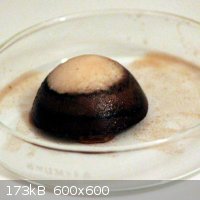
the tip is undissolved soda. i think the layers are due to fluctuations in throughput due to the solution shrinking below the anode level, and later
being filled up.
after the convex side dried up, the mass was turned over. the flat side was covered in brown/purple crystals, like a geode. unfortunately i wasn't
able to capture the crystalline look, as the residual soda solution quickly dried and covered it in white too:
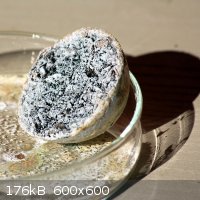
sadly this was the most interesting part of the experiment. the leftover electrolyte has almost completely solidified, the filtrate looks a rusty
brown. i'll try to verify if there's any chromate in there.
edit. no appreciable change with thiosulfate.
[Edited on 16-10-2012 by tetrahedron]
|
|
|
blogfast25
International Hazard
    
Posts: 10562
Registered: 3-2-2008
Location: Neverland
Member Is Offline
Mood: No Mood
|
|
Quote: Originally posted by 12AX7  | Hmm, K2CrO4 has higher solubility than K2Cr2O7. Might be useful. pH swing crystallization or something? Take your impure mixture, add an estimated
stoich amount of KOH, wait to dissolve; evaporate to saturation, then add HCl. KCl and NaCl stay put (unless they are also at saturation, in which
case the added chloride may drop a small amount; a second pass should be clean).
And, of course, collect all wastes and crystallize out all the orange and not-orange stuff and repeat...
Tim |
That's an interesting thought, Tim. For it to work, good control of concentration would be required. But it would be great to see the dichromate drop
out on acidification!
|
|
|
Salmo
Harmless

Posts: 42
Registered: 20-9-2012
Member Is Offline
Mood: No Mood
|
|
Ok my experiment failed today on purification, but as a good scientist  I didn't
give up and today I'm starting again. I didn't
give up and today I'm starting again.
Maybe chromates are not so interesting compounds because there are better ones but I want to develope the right procedure because I love OTC
chemistry and I think that chromates could be the cheap choice for the poor home chemist (like me) to do his oxidations.
Anyway blogfast you're right as always, stoichiometric calculations and quantities are absoluteley necessary with this procedure unfortunately I
understood this just today!
Today I started the dissolution of a 40g 18/10 stainless steel in 220ml (I'm using an excess) 37-38% H2SO4 (5M)
These are the calculations:
Iron: 28.8g (0.516mol)
Nickel: 4g (0.068mol)
Chromium: 7.2g (0.138mol)
SS dissolution in H2SO4 37-38%:
Fe + H2SO4 -> FeSO4 + H2
Ni + H2SO4 -> NiSO4 + H2
2Cr + 3H2SO4 -> Cr2(SO4)3 + 3H2
TOTAL H2SO4 moles necessary: 0.791 TOTAL H2SO4 37-38% mL necessary: 160ml
Then before precipitation I will first boil down and than filter the dark green solution to remove unreacted stuff like carbon.
Precipitation with NaOH:
FeSO4 + 2NaOH -> Fe(OH)2 + Na2SO4
NiSO4 + 2NaOH -> Ni(OH)2 + Na2SO4
Cr2(SO4) + 6NaOH -> 2Cr(OH)3 + 3Na2SO4
TOTAL NaOH moles necessary: 1.582 moles TOTAL NaOH grams necessary: 63.28g
Then I will filter and wash many times the green precipitate to eliminate 102.55g of Na2SO4, so I calculated that I will need 16.56g (of NaOH to make
this reaction happen:
[Cr(H2O)3(OH)3] + 3OH- -> [Cr(OH)6]3- + 3H2O
(I hope that the iron hydroxide precipitate won't hold too strongly the chromium hydroxide anyway I will heat the sludge for some time).
So I will add an unknown amount of 35% H2O2, it's hard to calculate because of hydrogen peroxide decomposition and Iron hydroxide oxidation reaction
that takes place at the same time, the Schikorr reaction:
3 Fe(OH)2 -> Fe3O4 + H2 + 2 H2O
Maybe using less than 16.56g of NaOH could be better I mean it would be less risky even if the yeld would be lower, I think I will use 15.00g instead.
But wait, there is another problem.
This is the reaction for the oxidation of Cr(III) to Cr(VI)
2[Cr(OH)6]3- + 3H2O2 -> 2[CrO4]2- + 2OH- + 8H2O
As you can see the oxidation reaction produces 2 moles of NaOH for each mole of chromate produced and this is not good because we will have a lot of
salt to remove in the purification stage and this is really hard.
So we have to think about it, maybe the key is to lower the NaOH quantity because some would be generated “in situ” from the oxidation but is that
possible to calculate? I don’t know I just know that I have to put 3 moles of sodium hydroxide to produce 1 mole of sodium chromate and 1 mole of
sodium hydroxide. Maybe we have to use 2/3 of the initial quantity? So 11.04 grams? I would put 10 grams to stay safe and I would do the
dissolution/oxidation while heating and stirring well the sludge/solution because of the lower initial concentration of sodium hydroxide.
What do you think?
[Edited on 16-10-2012 by Salmo]
|
|
|
tetrahedron
Hazard to Others
  
Posts: 210
Registered: 28-9-2012
Member Is Offline
Mood: No Mood
|
|
what's the ratio in your "drano"? i used stoichiometric amounts according to the reaction
Cr2O3 + 3KNO3 + 4KOH ---> 2K2CrO4 + 3KNO2 + 2H2O
but i read elsewhere that the nitrate acts as a catalyst for air oxidation, so the nitrate can actually be less, right?
Quote: Originally posted by plante1999  | | Like I already said, It take time is inefficient , but It work. If your S.S is hard to dissolve use Sodium bicarbonate electrolyte, It should help for
the dissolution of the Chromium. The idea is that the Ph is lowered increasing corrosion of iron. |
i repeated the experiment with a dilute Na2CO3 electrolyte this time. Again I can't say for sure it was successful, although the
higher voltage did help in corroding the stainless steel somewhat. OTOH in a diluted NaCl electrolyte the anode corroded quickly and efficiently, but
no chromate was observed.
|
|
|
violet sin
International Hazard
    
Posts: 1475
Registered: 2-9-2012
Location: Daydreaming of uraninite...
Member Is Offline
Mood: Good
|
|
salmo: ok so what you are saying is... the 3Na+ in solution gets absorbed with the [Cr(OH)6]3- ion. but upon oxidation only 2 are taken up by the
chromate and/or dichromate. leaving one mole in solution. to cancel. which leaves a 1:1 ratio of leftover Na2SO4 per each Na2Cr2O7(or Na2CrO4).
means a 50% contamination. LAME!!
but check this from melcor in ref section:
J. Fritzsche added a warm soln. of potassium
dichromate to an excess of conc, sulphuric acid ; the chromic anhydride separates
in small red crystals. The liquid is drained from the crystals, which are then
dried on a porous tile over sulphuric acid. The crystals are then recrystallized
from an aq. soln. P. A. Bolley said that the chromic anhydride so prepared
contains a little sulphuric acid as impurity and the Metals Protection Corporation
removed the sulphate by means of barium hydroxide, carbonate, or chromate.
R. Bunsen, A. V. Rakowsky, A. Dalzell, F. Dietze, 0. Ficinus, H. Moissan
so it seems that if you get a decent dichromate sol (even if it has Na2SO4 from acidification i think). treat sol w/ some con. H2SO4 and ppt. red
chromic anhydride crystals. (weird cause CrO3 is solubile in H2SO4?) with still totally soluble Na2SO4?.... effectively separating with
minimal/acceptable losses. resolovate with min H2O then drop out remaining H2SO4 contamination w/ barium as BaSO4 ppt. but don't overshoot. filter you
aq. chromic acid solution free of Ba2(SO4)3 (aq sol, 0.00024g/100ml @25'C) and dehydrate or not... with pure chromic anhydride, make chromic acid
all you would have to do is add a carbonate of K/Na and let the CO2 gas off right? sounds like the button to win, so I'm gonna press it. have a lill
bit of NO3- left in sol but decomp heating should kill it
I am going to try a 5-10ml sample tonight. going to be last experiment for a while 
|
|
|
Salmo
Harmless

Posts: 42
Registered: 20-9-2012
Member Is Offline
Mood: No Mood
|
|
You had a nice idea violet sin but sadly I've no con. Sulfuric acid.. And another thing I hope that no Na2SO4 would co-precipitate I mean I don't know
its solubility in con.sulfuric acid.. Anyway why not to try?
Today I will try to use math to solve the NaOH problem even if I think that using 10g or less like 8 would solve the problem without loosing precious
time  what I think is that there is a consumption of sodium hydroxide so the
reaction stops at a certain time and all the NaOH is over. what I think is that there is a consumption of sodium hydroxide so the
reaction stops at a certain time and all the NaOH is over.
|
|
|
violet sin
International Hazard
    
Posts: 1475
Registered: 2-9-2012
Location: Daydreaming of uraninite...
Member Is Offline
Mood: Good
|
|
after putting a few ml of con H2SO4 in a testtube, I added a few drops of sodium dichromate. my straw color ACE hardware acid turned a smokey red,
and yet clear top layer. 1/8" thick. but when I cam back to it a while later I found a bright red opaque line on the side of the tube at solution
line. it was bright red and kinda looked like tiny particles of sand. got a pic but not time to put it up. it was a very verry small amount. but
clearly visible. and unlike any other sulfate or chromate/dichromate I have seen to this point. so I believe it was indeed chromic anhydride. I
tried to fish some out to try a drop of MeOH on it(saw youtube vid w/ CrO3-EtOH = flames). I could feel it crunching as I tried to get it out. but
most stuck to the testube wall.
it seems to be produced and if shaken dissolves again. I noticed this bright opaque lipstick colored ppt on initial addition of the dichromate sol.
but shook it and turned into a red/rootbeer colored band. may be tiny dispersed crystals. I retried and got the above results. with the red line by
not disturbing it.
also from one of my last attempts to ppt the dichromate pissed me off, so I returned it to chromate boiled down(in prep to oxidize again) a bit and
left stand for a day while trying to figure it out. came back to BIG LONG bright yellow crystals. sever were 3" long and roughly 2/3 the diameter of
a standard pencil. I broke one open see if it was just sodium sulfate coated with a vibrant chromate... but no it was yellow all the way through.
I know I had a lot of Na2SO4 in there, but it seems to have formed another complex with the chrome ions. again I have pictures but will have to wait
till later today to retrieve them from my phone resize and post.
doesn't seem like it would be feasible to do for small scale with a decent return, and with large scale you have a LOT of hexavalent Cr and con. H2SO4
laying around... but was worth a try. would like to see some large CrO3 some day.
|
|
|
DerAlte
National Hazard
   
Posts: 779
Registered: 14-5-2007
Location: Erehwon
Member Is Offline
Mood: Disgusted
|
|
There seems to be an increased interest in the forum recently re Chromium compounds. I have collated the segments I wrote in this thread into a single
document and made it available as
http://www.sciencemadness.org/scipics/Chromium%20Revisited.d...
I have not changed the content except for a few typos. Any original errors will still exist (there are always some!). Don’t go copying it for term
papers, etc. It may not be academically correct. For amateur use only! Always read several references, not just one…
Regards, Der Alte
|
|
|
tetrahedron
Hazard to Others
  
Posts: 210
Registered: 28-9-2012
Member Is Offline
Mood: No Mood
|
|
thank you, a lot of great info
|
|
|
blogfast25
International Hazard
    
Posts: 10562
Registered: 3-2-2008
Location: Neverland
Member Is Offline
Mood: No Mood
|
|
Salmo:
Forget about the Schikorr reaction, it doesn’t happen in those circumstances. But it helps to get the stoichiometries right (here with K instead of
Na):
For the oxidation of the chromic hydroxide to chromate:
Cr(OH)3 + 2 KOH + 3/2 H2O2 === > K2CrO4 + 4 H2O
For the conversion of the chromate to dichromate with HCl:
K2CrO4 + HCl === > ½ K2Cr2O7 + KCl + ½ H2O
Overall:
Cr(OH)3 + 2 KOH + HCl + 3/2 H2O2 === > ½ K2Cr2O7 + KCl + 9/2 H2O
So bearing in mind that you’re also alkali oxidising Fe2+ to Fe(OH)3 , estimating how much H2O2 you need isn’t difficult. Use a calculated excess
(e.g. 20 % extra) and add to chilled slurry to avoid losing too much H2O2 to simple decomposition. Then simmer the slurry a bit to decompose residual
peroxide. Filter to extract chromate.
Interestingly it also shows that if dichromate is the goal, an accompanying K or Na salt is always inevitable.
[Edited on 17-10-2012 by blogfast25]
|
|
|
Salmo
Harmless

Posts: 42
Registered: 20-9-2012
Member Is Offline
Mood: No Mood
|
|
I'm an idiot  I didn't see that you (blogfast) merged the two equations in one
anyway I think that you are right it is simpler than i thought about the sodium hydroxide, in one two days I will finish my fourth experiment about
chromates.. today I finished the dissolution of my 40g fork in sulfuric acid I will post a useless photo in some minutes! I didn't see that you (blogfast) merged the two equations in one
anyway I think that you are right it is simpler than i thought about the sodium hydroxide, in one two days I will finish my fourth experiment about
chromates.. today I finished the dissolution of my 40g fork in sulfuric acid I will post a useless photo in some minutes!
Thank you really much DerAlte really useful document.
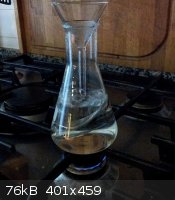 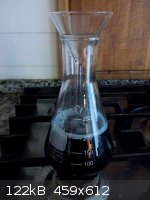
[Edited on 17-10-2012 by Salmo]
[Edited on 17-10-2012 by Salmo]
|
|
|
tetrahedron
Hazard to Others
  
Posts: 210
Registered: 28-9-2012
Member Is Offline
Mood: No Mood
|
|
yesterday i took some of the sludge that i got when "electrodissolving" stainless steel in a Cl- containing electrolyte and poured it into
a fresh solution of NaOH and NaCl (about 1 spoonful each in 400ml tap water), which i then electrolyzed for a couple hours with a 5mm diameter
graphite "gouging rod" anode, initially @ ~7V, soon reduced to 4.4V & 3A in order to reduce the loss of chlorine. i noticed a faint chlorine smell
during the procedure (it was done outside), as well as after unplugging the current. even after standing overnight i still noticed some bubbling,
which i can't explain.
the chloride only acts as a catalyst, first converting at the anode into chlorine and immediately afterwards to hypochlorite, which oxidizes Cr(III)
to Cr(VI), reverting to chloride.
the filtrate looks promising
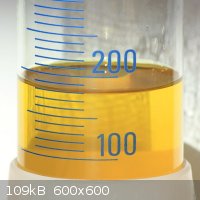
although i still don't have a way to quantitate the chromate present, and i can't tell how much chromite is contributing to the color.
[Edited on 18-10-2012 by tetrahedron]
|
|
|
blogfast25
International Hazard
    
Posts: 10562
Registered: 3-2-2008
Location: Neverland
Member Is Offline
Mood: No Mood
|
|
Tetrahedron:
Have you tested for chrmate with a lead (II) salt solution?
|
|
|
Salmo
Harmless

Posts: 42
Registered: 20-9-2012
Member Is Offline
Mood: No Mood
|
|
What do you mean when you say chromite?
anyway your method is nice even if you will have many impurities. You first generate chromium chloride than you precipitate it and than some is
dissolved from some hydroxide than the "in-situ" generated sodium hypochlorite oxidize Cr(III) to Cr(VI).. ok but you know that a yellow color
doesen't mean anything about the quantity of sodium chromate present? Anyway add some acid and look if your solution turns orange.
[Edited on 18-10-2012 by Salmo]
|
|
|
tetrahedron
Hazard to Others
  
Posts: 210
Registered: 28-9-2012
Member Is Offline
Mood: No Mood
|
|
no, unfortunately i don't have any lead salts. i guess calcium could also work, but it'll have to wait.
Quote: Originally posted by Salmo  | What do you mean when you say chromite?
anyway your method is nice even if you will have many impurities. You first generate chromium chloride than you precipitate it and than some is
dissolved from some hydroxide than the "in-situ" generated sodium hypochlorite oxidize Cr(III) to Cr(VI).. ok but you know that a yellow color
doesen't mean anything about the quantity of sodium chromate present? Anyway add some acid and look if your solution turns orange.
|
thanks, however allow me a correction. i don't generate chromium chloride (because the first electrolyte is not acidic), but chromium oxide/hydroxide
(along with the corresponding Fe and Ni compounds, and carbon, and who knows what other additives are in steel cutlery), which precipitates out
forming the aforementioned sludge.
by "chromite" i mean the soluble anion CrO2- given by the Cr(III) in alkaline solution. i don't know what this looks like,
probably lime green.
of course the color can be deceiving..however i compared it to the leachate of the alkaline melt method and i made a 50% educated, 50% wishful guess
that i got it right, and called it a day ;p
[Edited on 18-10-2012 by tetrahedron]
|
|
|
elementcollector1
International Hazard
    
Posts: 2684
Registered: 28-12-2011
Location: The Known Universe
Member Is Offline
Mood: Molten
|
|
I've tried reducing my Cr(III) solution (reduced with acid+alcohol) with baking soda + boiling water with no results. I think I'm going to suck it up
and try boiling the emerald green solution down, then adding weak NaOH to get my Cr(OH)3.
Elements Collected:52/87
Latest Acquired: Cl
Next in Line: Nd
|
|
|
tetrahedron
Hazard to Others
  
Posts: 210
Registered: 28-9-2012
Member Is Offline
Mood: No Mood
|
|
Quote: Originally posted by elementcollector1  | | I've tried reducing my Cr(III) solution (reduced with acid+alcohol) with baking soda + boiling water with no results. I think I'm going to suck it up
and try boiling the emerald green solution down, then adding weak NaOH to get my Cr(OH)3. |
no no no..oxidize! you're in the wrong thread ;p
|
|
|
elementcollector1
International Hazard
    
Posts: 2684
Registered: 28-12-2011
Location: The Known Universe
Member Is Offline
Mood: Molten
|
|
...Dangit!
Elements Collected:52/87
Latest Acquired: Cl
Next in Line: Nd
|
|
|
violet sin
International Hazard
    
Posts: 1475
Registered: 2-9-2012
Location: Daydreaming of uraninite...
Member Is Offline
Mood: Good
|
|
hey here are the pictures I meant to post 
red chromic anhydride from the warm dichromate dropped into concentrated H2SO4. the tube was laid to rest for a while tipped a bit and made the
opaque crystals.(lill red upside down smile)
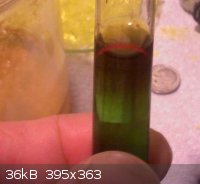
here are the large crystals that grew over a day or so when I got mad about the Na sulfate contamination. not too bad for growing that quick in a
200ml flask. still not 100% sure what the composition is though.
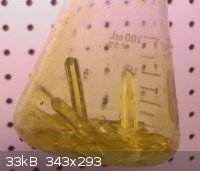
here is most the pile in a watch glass next to a dime for size comparison.
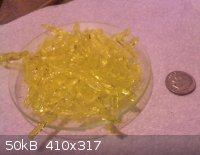
sorry the pic's aren't the best only off my phone. but *seems* that the chromic anhydride description from the reference book worked just fine.
|
|
|
Salmo
Harmless

Posts: 42
Registered: 20-9-2012
Member Is Offline
Mood: No Mood
|
|
Hey violet wonderful crystals ! I think they could be pure
|
|
|
blogfast25
International Hazard
    
Posts: 10562
Registered: 3-2-2008
Location: Neverland
Member Is Offline
Mood: No Mood
|
|
Quote: Originally posted by violet sin  |
here are the large crystals that grew over a day or so when I got mad about the Na sulfate contamination. not too bad for growing that quick in a
200ml flask. still not 100% sure what the composition is though.
|
Wonderful crystals indeed, but what are they? The solubilities at 20 C (Wiki solubility table) of sodium chromate and sodium sulphate are respectively
84 and 19.5 g/100 ml. If sodium sulphate is present in appreciable quantities it could well crystallise out first.
You really need to take some of your crystals, crush them up and dissolve them in a minimum of hot water, then allowed to crystallise again and see
what they look like…
|
|
|
blogfast25
International Hazard
    
Posts: 10562
Registered: 3-2-2008
Location: Neverland
Member Is Offline
Mood: No Mood
|
|
Meanwhile I’ve done another chromate/dichromate experiment, this one aimed at staying close to stoichoimetry outlined above and keeping the solution
as concentrated as possible, with a view of possible precipitating the Cr as dichromate in acidification.
1/10 mol of ‘Cr(OH)3’ was prepared from chromic sulphate hydrate by precipitation with NaHCO3, filtering and washing the green precipitate. The
obtained paste, about 167 g (containing about 10.3 g of ‘Cr(OH)3’) was quantitatively transferred into a 500 ml beaker.
To it was then added 14 g KOH (about 10 % excess and accounting for water in the KOH) dissolved in 15 ml water. The paste partly dissolved and a thin,
green-blue slurry of potassium chromite/’Cr(OH)3’ was obtained.
To this slurry, chilled 35 % H2O2 was added from a 10 ml burette, very slowly. Stoichiometrically about 15 ml would be required. At first everything
went well: the slurry gradually changed colour (from green blue to khaki brown), it also thinned further and the colour of the liquid phase (on my
glass stirring rod) was yellow. There was modest effervescence and gradual warming of the slurry. But after adding 30 ml of 35 % H2O2 the slurry still
hadn’t cleared up fully (there should be more than enough water to carry all the formed potassium chromate) and I stopped adding peroxide. Final
volume was by then about 200 ml, temperature about 45 C and pH about 7 – 8 (by paper).
I then simmered the slurry for a bit and allowed it then to stand and cool. Below is a photo of it after about 15 minutes of standing:

The supernatant liquid clearly shows there is chromate in solution (although at that pH perhaps chromate/dichromate in equilibrium) but there is also
a considerable amount of an unexplained brown, heavy (it sinks pretty fast) precipitate. Note that bad lighting shows the liquid far
darker than it is to the naked eye. It's really strong yellow.
The fairly low pH at the end is of course a bit worrying: did oxidation stop because of lack of alkalinity? How then to explain the brown precipitate?
Tomorrow the supernatant liquid will be decanted off and some test tube tests will be done on the precipitate.
[Edited on 21-10-2012 by blogfast25]
|
|
|
Arthur Dent
National Hazard
   
Posts: 553
Registered: 22-10-2010
Member Is Offline
Mood: entropic
|
|
Yup, as blogfast25 mentioned, dissolution and recrystallisation of those lovely crystals will probably help you isolate a product that's more pure, as
well as give you a good idea of the solubility of the crystals you grew, so that you could end up with a cleaner product after a few
recrystallisations . Sodium sulfate crystals should be snow white, and sodium chromate crystals are a bright, intense canary yellow, and should form
before the sulfate crystals.
BTW glad to see you're back 12AX7, it's been a hell of a while! 
Robert
--- Art is making something out of nothing and selling it. - Frank Zappa ---
|
|
|
elementcollector1
International Hazard
    
Posts: 2684
Registered: 28-12-2011
Location: The Known Universe
Member Is Offline
Mood: Molten
|
|
Sodium bicarbonate works too?
Anyway, I had some Cr(III) in solution and a small chunk of NaOH was tossed in; it all effortlessly turned yellow. No H2O2 was needed...
Elements Collected:52/87
Latest Acquired: Cl
Next in Line: Nd
|
|
|
blogfast25
International Hazard
    
Posts: 10562
Registered: 3-2-2008
Location: Neverland
Member Is Offline
Mood: No Mood
|
|
Quote: Originally posted by elementcollector1  | Sodium bicarbonate works too?
Anyway, I had some Cr(III) in solution and a small chunk of NaOH was tossed in; it all effortlessly turned yellow. No H2O2 was needed...
|
Whatever happened, it can't be oxidation of Cr3+ to chromate: that really does require a powerful oxidiser. Tst for chromate with a lead (II) salt
(yellow PbCrO4 precipitates)
Yes, in many cases NaHCO3 is a strong enough alkali to precipitate a hydroxide. In some case you'll obtain a basic carbonate though. Cr doesn't appear
to form one of those though...
|
|
|
| Pages:
1
2
3
4
5 |